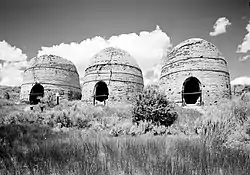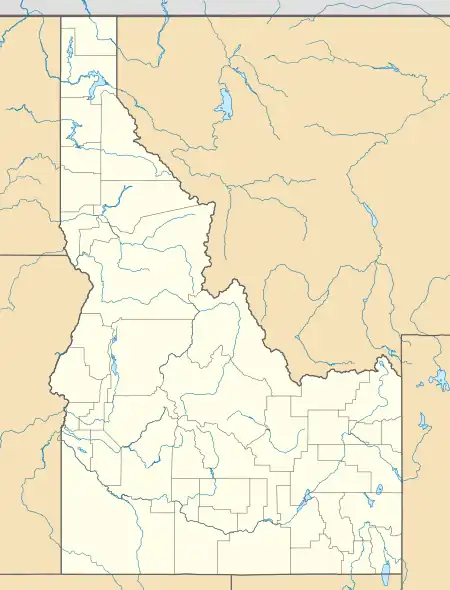Birch Creek Charcoal Kilns
The Birch Creek Charcoal Kilns are a group of beehive-shaped clay charcoal kilns near Leadore, Idaho, built in 1886. They were listed on the National Register of Historic Places in 1972.
Charcoal Kilns | |
 | |
  | |
| Nearest city | Leadore, Idaho |
|---|---|
| Coordinates | 44°18′40″N 113°10′44″W |
| Area | 6 acres (2.4 ha) |
| Architect | Warren King |
| NRHP reference No. | 72001577[1] |
| Added to NRHP | February 23, 1972 |
The kilns were built in 1886 to produce charcoal to fuel the smelter at Nicholia, which smelted lead and silver ore from the Viola Mine located about 10 miles east of the kilns.[2][3][4][5] The Viola ore deposit was discovered in 1881 and was mined until 1888, when the ore was depleted and the price of lead had fallen.[3][6] The Nicholia smelter, located about 3 miles west of the mines, had two blast furnaces, each with a daily capacity of 40 short tons (36 t) of ore.[2][3][4][5][6]
A Butte, Montana, man named Warren King built 16 kilns from brick made from local clay, possibly obtained from Jump Creek on the east side of the Birch Creek valley. The beehive-shaped kilns are each about 20 feet (6.1 m) tall and 20 feet (6.1 m) in diameter. When operating, each kiln used 30 to 40 cords of Douglas fir wood per load, producing about 1,500 to 2,000 bushels (70 cubic meters) of charcoal over a two-day burn. The kiln operation lasted for less than three years, employing 150 to 200 people at its peak, and had a monthly output estimated at 44,000 to 50,000 bushels (1550 to 1762 cubic meters) of charcoal.[2][3][4][5][7]
The ruins of four kilns survive.[2][5] They are located on the Caribou-Targhee National Forest, which operates the location as a public interpretive site.[3][7] Nicholia is now a ghost town, with only a few ruins remaining.[8] There are no surviving remains of the town of Woodland, a short distance south of the kilns, where the kiln workers lived.[2][5] The kilns were listed on the National Register of Historic Places in 1972. The listing included four contributing structures on 6 acres (2.4 ha).[1] In 1987, a volunteer-assisted stabilization effort prevented one of the kilns from collapsing.[9] The Forest Service undertook a restoration of the kilns in 2000.[4]
References
- "National Register Information System". National Register of Historic Places. National Park Service. July 9, 2010.
- "Forest Service Saves 1886 Charcoal Kilns" (PDF). Society for Industrial Archeology Newsletter. 16 (4). Winter 1987.
- "Charcoal Kilns Interpretive Site". U.S. Forest Service. Retrieved August 22, 2012.
- "Charcoal Kilns Interpretive Site Overview/Background". U.S. Forest Service. Retrieved August 22, 2012.
- "Birch Creek Charcoal Kilns". Idaho Heritage Trust. Retrieved August 22, 2012.
- Mitchell, Victoria E. (February 2010), History of the Viola Mine, Lemhi County, Idaho (PDF), Idaho Geological Survey, archived from the original (PDF) on 2015-09-18, retrieved 2012-08-23
- "Charcoal Kilns, Idaho". Public Lands Information Center. Public Lands Interpretive Association. Retrieved August 22, 2012.
- Collias, Nicholas (September 8, 2004). "Dead Ore Alive; The eerie pleasures of Idaho's obscure mining towns". Boise Weekly.
- Huegel, Tony (June 4, 1987). "Brick Mason Volunteers Time To Repair Charcoal Kilns". Spokesman-Review and Spokane Chronicle.
External links
- Historic American Engineering Record (HAER) No. ID-11, "Warren King Charcoal Kilns, Targhee National Forest, Leadore, Lemhi County, ID", 11 photos, 20 data pages, 2 photo caption pages